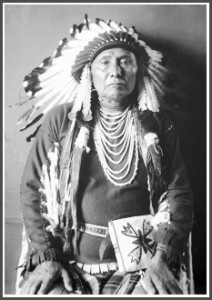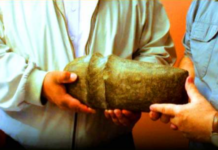
Sheep in Ancient North America
For many years I have known about Chief Joseph of the Nez Perce tribe. I learned in school how brave he was during his forced surrender to the US Government. I also had remembered about a square shaped stone that was found with him and that is was very ancient. I recently was reading about Chief Joseph and have found some amazing things that tie in with Book of Mormon Geography. It is well established there are no ancient sheep found in Mesoamerica at the time of the Book of Mormon, but artifacts about sheep have been found in North America. (See Hopewell Artifacts above, and my blog Here.) I found it very interesting that on this square shaped stone was found wedge-shaped characters used in the ancient writing systems of Mesopotamia called cuneiform. It spoke about the purchase of sheep and goats for a sacrifice. In total there are three artifacts found in the USA with the ancient cuneiform script that have been studied by reputable archaeologists and deemed authentic. They are sales receipts for sheep and goats. Amazing. Below are the details.

From Josephknew.com: “In 1877 the respected leader of the Nez Perce tribe surrendered to the U. S. Government. At his surrender, Chief Thunder Rolling Down the Mountain (known by his Christian name Joseph), presented General Nelson Appleton Miles with a pendant, a 1 inch square clay tablet with writings unrecognizable to General Miles. The writing, which was translated by Dr. Robert D. Biggs, Assyriology Professor at the University of Chicago, turned out to be a sales receipt dating back to 2042 B.C. in Assyria. It read:
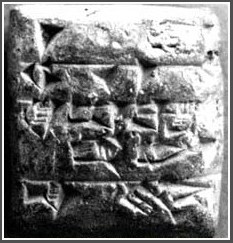
(Interpretation picture right)“Nalu received
1 lamb from Abbashaga on the 11th day of the month of the festival of An, in the year Enmahgalanna was installed as high priestess of Nanna.”
Chief Joseph said the tablet had been passed down in his family for many generations. How would his family come into possession of a nearly 4,000-year-old tablet? According to the Chief, they inherited it from their white ancestors.
 Other tablets with an Assyrian connection have been found throughout North America. A tablet similar in size and appearance to The Chief Joseph tablet was found in 1963 in northwestern Georgia near the Chattahoochee River. (*Information below) Like the Chief Joseph tablet, this one was a receipt for the sale of sheep and goats that were to be used in a ceremonial sacrifice. From other information contained on the tablet, it appears to have been created in 2040 B.C. One difference is the Georgia tablet was made of lead.
Other tablets with an Assyrian connection have been found throughout North America. A tablet similar in size and appearance to The Chief Joseph tablet was found in 1963 in northwestern Georgia near the Chattahoochee River. (*Information below) Like the Chief Joseph tablet, this one was a receipt for the sale of sheep and goats that were to be used in a ceremonial sacrifice. From other information contained on the tablet, it appears to have been created in 2040 B.C. One difference is the Georgia tablet was made of lead.
When Chief Joseph surrendered to General Miles, he had the tablet in his medicine bag. That bag was itself an interesting connection to Ancient Assyria.
 In an April, 2001 article published in Assyria Times, Benjamin Daniali points out a connection between an Assyrian symbol known as the Ashur Star and the design on Chief Joseph’s medicine bag.
In an April, 2001 article published in Assyria Times, Benjamin Daniali points out a connection between an Assyrian symbol known as the Ashur Star and the design on Chief Joseph’s medicine bag.
In this photo of an ancient relief sculpture we can see the Assyrian god Ashur upon his throne. In front of him is a disc with the symbol known as the Assyrian Star or the Ashur Star. It is a four-pointed star with a circle in the center. Radiating out from between the four points of the star are rays of light.

In photos of Chief Joseph we can see this same design on his medicine bag.

How could the Nez Perce and other tribes in North America have 4,000-year-old Assyrian artifacts handed down for generations? Why would Chief Thunder Rolling Down the Mountain have a Star of Ashur beaded on his medicine bag?
Sometime near the beginning of the Assyrian Empire — which ran from 2,500 B.C. to 605 B.C. — a tower was built in Assyria (modern day Iraq) to reach heaven. As a result, languages were confounded and families were scattered.
Mahonri Moriancumer, the brother of Jared, pleaded with the Lord to not confound his language and that of his closest friends. They left Assyria and traveled “across many waters” to a promised land. They became a mighty nation in the place they called Moriancumer. Could the Chief Joseph tablet have come with them across the waters? Could the Jaredites have preserved their language and Assyrian culture in North America?” Copyright © 2015 by Energy Media Works LLC
On October 5, 1877, his speech, as he surrendered to General Howard, immortalized him in American history forever:
In 1904 Chief Joseph died, according to his doctor, of a broken heart.

“I am tired of fighting. Our chiefs are killed. Looking Glass is dead. Toohoolhoolzote is dead. The old men are all dead. It is the young men who say, ‘Yes’ or ‘No.’ He who led the young men [Olikut] is dead. It is cold, and we have no blankets. The little children are freezing to death. My people, some of them, have run away to the hills, and have no blankets, no food. No one knows where they are — perhaps freezing to death. I want to have time to look for my children, and see how many of them I can find. Maybe I shall find them among the dead. Hear me, my chiefs! I am tired. My heart is sick and sad. From where the sun now stands I will fight no more forever.” — Chief Joseph —

“The Red Nation shall rise again and it shall be a blessing for a sick world; a world filled with broken promises, selfishness and separations; a world longing for the light again. I see a time of Seven Generations when all the colors of mankind will gather under the Sacred Tree of Life and the whole Earth will become one circle again. In that day, there will be those among the Lakota who will carry knowledge and understanding of unity among all living things and the young white ones will come to those of my people and ask for this wisdom. I salute the light within your eyes where the whole universe dwells. For when you are at the center within you and I am that place within me, we shall be one.” Crazy Horse, Oglala Sioux (1840-1877)
Sacrifices
To understand the significance of Joseph’s Tablet we need to understand more about animal sacrifice.
 “Soon after Adam and Eve were cast out of the Garden of Eden, the Lord gave them the law of sacrifices, which included offering the firstlings of their flocks in a similitude of the sacrifice that would be made of the Only Begotten Son of God (Moses 5:4–8). Thereafter, whenever there were true believers on the earth, with priesthood authority, sacrifices were offered in that manner and for that purpose. This continued until the death of Jesus Christ, which ended the shedding of blood as a gospel ordinance. It is now replaced in the Church by the sacrament of the bread and the water, in remembrance of the offering of Jesus Christ.” LDS Bible Dictionary/Sacrifice
“Soon after Adam and Eve were cast out of the Garden of Eden, the Lord gave them the law of sacrifices, which included offering the firstlings of their flocks in a similitude of the sacrifice that would be made of the Only Begotten Son of God (Moses 5:4–8). Thereafter, whenever there were true believers on the earth, with priesthood authority, sacrifices were offered in that manner and for that purpose. This continued until the death of Jesus Christ, which ended the shedding of blood as a gospel ordinance. It is now replaced in the Church by the sacrament of the bread and the water, in remembrance of the offering of Jesus Christ.” LDS Bible Dictionary/Sacrifice
This would mean that the family of the Brother of Jared would be offering sacrifices as we know the Jaredites were one of the most righteous of God’s people. Some members of the church have said to me that the Jaredites did not hold the priesthood and they weren’t even Christian, which I don’t believe. Read this great article which supports my feelings about this: Jared and His Brother
“Animal sacrifice was general among the ancient Near Eastern civilizations of Ancient Mesopotamia, Egypt and Persia, as well as the Hebrews. Unlike the Greeks, who had worked out a justification for keeping the best edible parts of the sacrifice for the assembled humans to eat, in these cultures the whole animal was normally placed on the fire by the altar and burned, or sometimes it was buried.” Wikipedia here

Timeline/Date
Adam Placed 4070 BC
Fall of Adam 4004 BC
City of Enoch taken 3313 BC
Noah born 2943 BC
Flood began 2343 BC
Peleg born 2241 BC
Abraham born 2052
Cuneiform tablets 2042 BC
Noah dies 1993 BC
Sodom & Gomorrah 1953 BC
Isaac born 1952 BC
Jacob born 1892 BC
Jared 1830 BC
Jacob/Rachel married 1808 BC
Judah born 1804 BC
Joseph born 1801 BC
Tower destroyed 1780 BC
Ephraim/Manasseh born 1767 BC
Jaredites in N. America 1676 BC
Moses born 1542 BC
10 Commandments 1462 BC
Moses translated 1422 BC
David born 1057 BC
Daniel captive 605 BC
Lehi departs 601 BC
Jaredites destroyed 600 BC
(Bold indicates North America)
Source JohnPratt.com
About Assyrians: All Things Assyrian From Stews to Stars: the World’s Oldest Writing
CLAY TABLET. FOUND: Babylon, Iraq. CULTURE: Late Babylonian. DATE: A.D. 62. LANGUAGE: Akkadian. ( The Trustees of the British Museum)
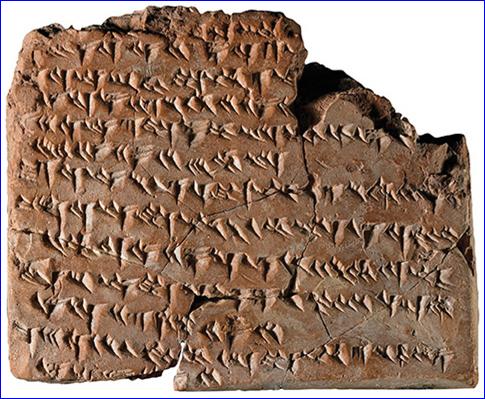

In early 2016, hundreds of media outlets around the world reported that a set of recently deciphered ancient clay tablets revealed that Babylonian astronomers were more sophisticated than previously believed. The wedge-shaped writing on the tablets, known as cuneiform, demonstrated that these ancient stargazers used geometric calculations to predict the motion of Jupiter. Scholars had assumed it wasn’t until almost A.D. 1400 that these techniques were first employed–by English and French mathematicians. But here was proof that nearly 2,000 years earlier, ancient people were every bit as advanced as Renaissance-era scholars. Judging by the story’s enthusiastic reception on social media, this discovery captured the public imagination. It implicitly challenged the perception that cuneiform tablets were used merely for basic accounting, such as tallying grain, rather than for complex astronomical calculations. While most tablets were, in fact, used for mundane bookkeeping or scribal exercises, some of them bear inscriptions that offer unexpected insights into the minute details of and momentous events in the lives of ancient Mesopotamians.
First developed around 3200 B.C. by Sumerian scribes in the ancient city-state of Uruk, in present-day Iraq, as a means of recording transactions, cuneiform writing was created by using a reed stylus to make wedge-shaped indentations in clay tablets. Later scribes would chisel cuneiform into a variety of stone objects as well. Different combinations of these marks represented syllables, which could in turn be put together to form words. Cuneiform as a robust writing tradition endured 3,000 years. The script–not itself a language–was used by scribes of multiple cultures over that time to write a number of languages other than Sumerian, most notably Akkadian, a Semitic language that was the lingua franca of the Assyrian and Babylonian Empires.

After cuneiform was replaced by alphabetic writing sometime after the first century A.D., the hundreds of thousands of clay tablets and other inscribed objects went unread for nearly 2,000 years. It wasn’t until the early nineteenth century, when archaeologists first began to excavate the tablets, that scholars could begin to attempt to understand these texts. One important early key to deciphering the script proved to be the discovery of a kind of cuneiform Rosetta Stone, a circa 500 B.C. trilingual inscription at the site of Bisitun Pass in Iran. Written in Persian, Akkadian, and an Iranian language known as Elamite, it recorded the feats of the Achaemenid king Darius the Great (r. 521–486 B.C.). By deciphering repetitive words such as “Darius” and “king” in Persian, scholars were able to slowly piece together how cuneiform worked. Called Assyriologists, these specialists were eventually able to translate different languages written in cuneiform across many eras, though some early versions of the script remain undeciphered.
Today, the ability to read cuneiform is the key to understanding all manner of cultural activities in the ancient Near East–from determining what was known of the cosmos and its workings, to the august lives of Assyrian kings, to the secrets of making a Babylonian stew. Of the estimated half-million cuneiform objects that have been excavated, many have yet to be catalogued and translated. Here, a few fine and varied examples of some of the most interesting ones that have been. Source here and here
Cuneiform in America 4000 years ago
Judging from the artifacts they left behind, the Assyrians and Sumerians made quite an extensive voyage to the Americas about 4000 years ago. This the first installment of a three entry blog that presents the evidence.
Chief Joseph’s Cuneiform Tablet
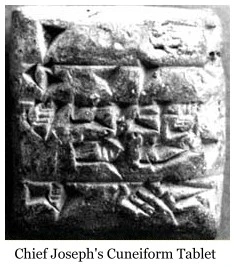
The most famous piece of evidence passed down among the Nez Perce tribe of Montana was a strange cuneiform tablet known to us as the Chief Joseph Tablet. Housed in the museum at West Point, this tablet was photographed by Warren C. Dexter in 1991, the tablet was taken from—some say gifted by—Chief Joseph when he was captured in 1877.
Chief Joseph, best known for his statement, “I will fight no more forever,” claimed he inherited it from his white ancestors and that it had been in his family for generations. He carried the inch square baked tablet in a medicine pouch with the Star of Ashur, an Assyrian symbol, on it. (That is the subject of my next blog.)
Translated by Professor Robert Biggs of the University of Chicago, the Chief Joseph tablet reads, “Nalu received 1 lamb from Abbashaga on the 11th day of the month of the festival of An, in the year Enmahgalanna was installed as high priestess of Nanna.” That would be 2042 BCE.
Now, some websites claim this tablet is a forgery, to which I would reply: Really? Chief Joseph knew the Assyrian language and wrote in cuneiform, you say. And he knew the history of the priestesses of Nanna, too. So tell me how Chief Joseph came by that knowledge in the 1880s? (That in itself is a good mystery—especially since cuneiform was first deciphered in 1857 in Britain.)
The Hearn Cuneiform Tablet
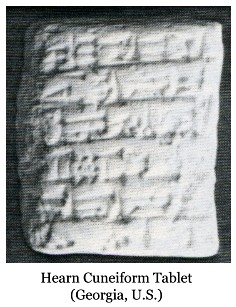
(*From above) The Hearn tablet was discovered in Georgia in 1963. It is a receipt for sheep and goats intended as sacrifice to the sun god Utu and the goddess Lama Lugal. The scribe, Enlila, states it was the 37th or 38th year of the reign of King Suigi of Ur, Sumeria. That dates this tablet to 2040 BCE, two years prior to the Chief Joseph tablet.
The Hearn tablet is made of lead, not clay. There are other lead pieces found on the Hearn property dated to the same time. So it would seem at least this tablet may have been created here in the Americas. Lead smelting and the need to create a receipt for goods exchanged, I would say, indicates a larger presence than just a handful of explorers.
The Shawnee Creek Stone of Oklahoma
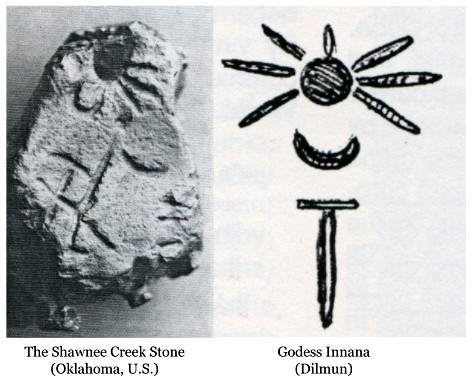
The Shawnee Creek Stone is yet a third important discovery.
According to Gloria Farley who was one of the pioneers of the movement to discover and preserve evidence of pre-Columbian trans-Atlantic travel:
“Borrowing the [Shawnee Creek] stone, I made a latex mold and my son Mark Farley obtained a clear photograph, both of which were sent to Dr. Barry Fell. His returning telephone call told me that he believed the find to be of great importance, as the design resembles the seals from ancient Dilmun in the Arabian Gulf. (This is the name which the Arabs give to the Persian Gulf. Dilmun was located mainly on the island of Bahrain.) The inscription, said Dr. Fell, appears to employ the ideographs used by Dilmunian scribes, especially the ones for ‘Inanna, Goddess of Love and Queen of Heaven.’ He told me that Inanna also related to the Sumerians. Sumer is now modern Iraq.”
Molds of the inscription were sent to Ali Akbar H. Bushiri a scholar of ancient Bahrain who wrote about the Dilmun culture. He confirmed that four of the five symbols related to Inanna. We have the circle with 8 rays (the Venus star), the vertical line with semicircle (Inanna), the “U” shape (Nanna, Moon God and father to Inanna), and the vertical line with 2 of 3 bars–the third bar having been chipped off (symbol of fertility).
Who was Inanna?
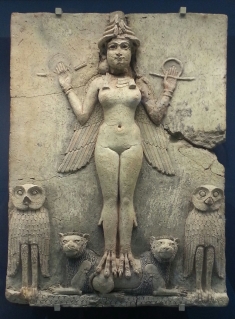
The reign of Inanna (also spelled Innana) as the Goddess of Love seems to have begun in 5300 BCE (the date for the “founding” of Sumer) and lasted right through the period of Akkadain rule in both Sumer and Assyria (2334-2218). Dilmun is south of Sumer. This places the Shawnee Creek Stone in the same date and geographic range as the two cuneiform tablets, although the stone could also have been much earlier or even later.
So we have one tablet (2042 BCE) that is Assyrian, one tablet (2040 BCE) that is Sumerian and one that is carved stone related to either Sumer or Assyria. All three can be related to one single era—just before the Akkandian rule of both Sumer and Assyria.
The question below should be an easy one. It is for members of The Church of Jesus Christ of Latter-day Saints, because we know about the Jaredites, Mulekites and Lehites. We know how common it is to travel the ocean anciently. If we could only convince the archaeologists and historians who want to still believe the Bering Strait theory.
How did these artifacts get to America?
It is argued that neither the Sumerian nor the Assyrian people were navigators and could not have made it to America. So how did the tablets come to be found in America?
We need to remember that the Akkadian period began with the conquest of Assyria and Sumeria by Sargon of Akkad. His desire to expand and gain power may have extended to exploration, even across the Atlantic.
But the two cuneiform tablets are dated firmly to 2042 and 2040 BCE and Sargon’s conquest is dated to 2334 BCE. So either the tablets were made in Assyria and Sumeria before the conquest and then brought to America during a later Akkadian exploration, or they were made in America signifying Assyrian/Sumerian exploration before Akkadian rule. In which case, we need to re-examine the statement that the Assyrians and Sumerians were not navigators. Perhaps they did navigate far distances, even across the Atlantic.

And we must remember Chief Joseph claimed his “white ancestors” passed the stone down through the generations. Is it possible that Assyrians and/or Sumerians came to this country to escape Sargon of Akkad and his conquering armies? If so, this would not be the last time the Americas became a haven for those escaping harsh conditions in their motherlands.
Credits:
Photos of the tablets and some basic information in this blog are from the much quoted articles by Benjamin Daniali of the Assyrian Times.
But for more detailed and substantiated information see: Farley, Gloria (1994). In Plain Sight: Old world records in ancient America. Muskogee, OK: Hoffman Printing Company (pp. 150-155). (There is a picture of the Shawnee Creek stone translation on p. 153.)Search
The Assyrian Times presents this comparison below as well: Source Here:


Additional Reading
The Lost Colonies of Ancient America: A Comprehensive Guide to the Pre Columbian Visitors who really Discovered America
By Frank Joseph

“After Hin-mah-too-yah-lat-kekt of the Wal-lam-wat-kain, a band of Nez Perce Indians, surrendered to units of the U.S. Cavalry near Chinook Chinook in the north of what is now Montana on October 5, 1877, his “medicine bag” containing a 1-inch-square baked clay tablet was stolen. Better remembered as Chief Joseph, he explained that the tablet, engraved on both sides with then inscrutable texts, “had been passed down in his family for many generations, and that they had inherited it from their white ancestors. Chief Joseph said that white men had come among his ancestors long ago, and had taught his people many things.” 34 Today, his ancestral heirloom is still warehoused at New York’s West Point Museum.
In 2000, Robert D. Biggs, an Assyriology professor at the Oriental Institute of the University of Chicago, with a PhD from Johns Hopkins University, and editor of the Journal of Near Eastern Studies , was able to translate the texts of Chief Joseph’s tablet, because they had been inscribed in cuneiform. They recorded the sale of a lamb for sacrifice on behalf of a person named Enmahgalanna to celebrate her promotion as a high priestess of Nanna, the same moon-god enshrined at Ur’s Great Ziggurat. Professor Biggs dated the Sumerian inscription to approximately 2042 BC . 35
Native American pouches such as the one Chief Joseph carried “contained items that would remind the warrior of home, of where he came from,” according to historical writer Mary Gindling. “The mundane nature of the contents of the tablet argues against forgery. Cuneiform had only been deciphered in 1846, and the process was far from complete even in 1877, so a would-be forger would had to have been an extremely well educated individual, familiar not only with the ancient language itself, but with the shape of the tablets created by the ancient scribes.” 36
Not long after the Cherokee artifact came to light, “a Sumerian tablet with cuneiform writing was found beside ancient stone projectile points near Lexington, Georgia,” writes Dr. Thompson. “The tablet is from Ur-Nammuk, Iraq, and dates to 2040 B.C.” 37
Cultural diffusionist researcher Gloria Farley tells of a similar discovery in the same state made by a Mrs. Joe Hearn:
In 1963, while digging a new flower bed on her property in northwestern Georgia, not far from the Chatahoochee River, her shovel had struck a small, pillow-shaped tablet made of lead.… The cuneiform script, according to Dr. Curtis Hoffman, describes how a scribe named Enlila was aware that it was the thirty-seventh or thirty-eighth year of the reign of King Shulgi of Ur, which by our reckoning, would have been about 2040 B.C. It recorded the sale of sheep and goats, which apparently had been transported overseas to America, for sacrifice to Utu, the sun-god, and the goddess, Lama Lugal [a Sumerian deity of intercession and protection]. 38
Editors Note: (See Map Below) I have made a probable connection that after Lehi landed near Tallahassee, Fl., Nephi and his brothers may have used the Chattahoochee River to escape north up into the Unicoi Gap of Georgia. From there the Hiawassee River would take them directly to the Tennessee River and straight into Chattanooga Tennessee, where I believe the City Nephi was located.

Although Shulgi actually ruled from 2029 to 1982 BC , Georgia’s Hearn object and Chief Joseph’s tablet both date to within 11 years of each other; their discoveries were separated by many hundreds of miles and two centuries, underscoring a common authenticity. LaGrange College, Georgia’s oldest private college, founded in 1831, today owns the Hearn Tablet.
Near Quaker City, Ohio, an amateur Indian arrowhead collector discovered a cuneiform tablet in 1978. Its ancient provenance was established by David Owen, professor of Near Eastern studies at Cornell University, in Ithaca, New York. He translated the Sumerian text, which had been composed “by a man named Ur-e’e in the month of Dumuzi [late June], in the year the ensi [ruler] of Karzida was elevated.” 39 Karzida was the second city of worship for Nanna, the same moon-god likewise referenced by the inscription on Chief Joseph’s tablet, suggesting a relationship between his family heirloom and the Quaker City find, which came to light years after his death. That relationship is remarkably cogent to our discussion, because they, together with the Lexington and Hearn tablets, were all inscribed within 12 years of each other, between 2042 and 2030 BC . They define the most appropriate segment of time for voyages to America, because it matches the dynamic outset of the Ur III Period, or “Sumerian Renaissance.”
It began in 2047 BC , just after the Sumerians liberated themselves from Akkadian domination and experienced their most energetic outward expansion, as exampled by the specimen of South African resin found in Queen Puabi’s tomb at Ur. “Many such Ur III tablets have been found in the U.S.,” states Professor Owen, “including some tablets dug up a few years ago from the ruins of an old apartment house in Auburn, New York.” 40
So many tablets spread over half a continent—from Montana to Georgia, Ohio, and New York—do not suggest some lone survivor of shipwreck, blown far off course during some otherwise-normal trading mission in the Middle East, but indicate rather the deliberate arrival of numerous Sumerian visitors, all from the same capital of Ur’s Third Dynasty.” The Lost Colonies of Ancient America, A Comprehensive Guide to the Pre-Columbian Visitors Who Really Discovered America Page 36-39
Notes:
34 Gindling, Mary. “History Mystery: Chief Joseph’s Cuneiform Tablet” ( www.stumbleupon.com/su/8Pv0tq/www.helium.com/items/1636848-hisdtory-mystery-chief-josephs-cuneiform-tablet , 2009).
35 Biggs, Robert D. “History Mystery.”
36 . Gindling. “History Mystery: Chief Joseph’s Cuneiform Tablet.”
37 . Thompson, American Discovery
38 . Farley, Gloria. “History Mystery.”
39 . Tiel, William. “Two Enigmatic Stones from Ohio,” Ancient American , vol. 9, no. 58 (August 2004).
40 . Although they agree that the four cuneiform tablets are authentically Sumerian, mainstream archaeologists dismiss them as insignificant. As described in Lost Civilizations , “Professor Owen ‘suggests that we are not to make too much of the (Quaker City) find,’ since ‘tablets of this type were sold throughout the U.S. in the early years of this (the 20th) Century, and have shown up in various places, including garbage dumps and garage sales.’ That does not explain Chief Joseph’s tablet, which became public knowledge in 1877, more than twenty years before the alleged importation of Sumerian relics, nor the Hearn Tablet, which was dug up on property consistently owned by the discoverer’s family since 1850. The Quaker City tablet itself was excavated from a depth of some two feet amid a cluster of Indian arrowheads—hardly the setting for a misplaced trinket from the early 20th Century. Moreover, a thorough Internet search by this author failed to turn up any suggestion that brisk sales in authentic cuneiform tablets occurred in the United States during the early 1900s, as Professor Owen stated without proof.” Source Here:

Cuneiform tablet impressed with cylinder seal. Receipt of goats, c. 2040 BC, year 7 of Amar-Sin. Neo-Summerian. https://en.wikipedia.org/wiki/Third_Dynasty_of_Ur
The Third Dynasty of Ur, also called the Neo-Sumerian Empire, refers to a 22nd to 21st century BC (middle chronology) Sumerian ruling dynasty based in the city of Ur and a short-lived territorial-political state which some historians consider to have been a nascent empire. The Third Dynasty of Ur is commonly abbreviated as Ur III by historians studying the period.
The Oklahoma Runestones If the tales told by the old-timers are correct, Oklahoma may once have contained dozens of runestones. Five of these have been found. This chapter discusses their discovery and possible meanings. Also, other possible runestones from Oklahoma and Arkansas are discussed.
The Lord will remember the Jew, the Lamanite, and the Native Americans
D&C 19:26-27 And again, I command thee that thou shalt not covet thine own property, but impart it feely to the printing of the Book of Mormon, which contains the truth and works of God.

27: Which is my word to the Gentile, that soon it may go to the Jew, of whom the Lamanites are a remnant that they may believe the gospel, and look not for a Messiah to come who has already come.
In Alma 24:19 And thus we see that, when these Lamanites were brought to believe and to know the truth, they were firm, and would suffer even unto death rather than commit sin, and thus we see that they buried their weapons of peace, or they buried the weapons of war, for peace.
“The converted Lamanite is devout. Few ever apostatize. Some lose their way as they partake of the worldliness about them, but generally the children of Lehi of the twentieth century have inherited that grace and ability to believe like their ancestors of the long ago. We read in Hel. 6:36: ‘And thus we see that the Lord began to pour out his Spirit upon the Lamanites, because of their easiness and willingness to believe in his words’” (The Teachings of Spencer W. Kimball, ed. Edward L. Kimball [Salt Lake City: Bookcraft, 1982], p. 178; emphasis added).
“The Lamanites must rise again in dignity and strength to fully join their brethren and sisters of the household of God in carrying forth his work in preparation for that day when the Lord Jesus Christ will return to lead his people, when the millennium will be ushered in, when the earth will be renewed and receive its paradisiacal glory and its lands be united and become one land. For the prophets have said, ‘The remnant of the house of Joseph shall be built upon this land; and it shall be a land of their inheritance; and they shall build up a holy city unto the Lord, like unto the Jerusalem of old; and they shall no more be confounded, until the end come when the earth shall pass away.’ (Eth. 13:8.) “In this I have great faith.” Spencer W. Kimball (“Our Paths Have Met Again,” Ensign, Dec. 1975, p 5, 7.)

“Have you ever tried to recover something that you have lost in your memory all at once, as you strain and struggle, here it comes back? That is the way the Gospel is to the Lamanites. One good Navajo man said to me: “All our lives we knew that we were off line. We used to be with you folks in the long ago; then we came to a division in the road with a great stone in the middle. We went one way and you went the other, but now we are around it and we are all coming back together (Lamanite Conference April 24, 1971 President Kimball).
Ether 13:8 “Wherefore, the remnant of the house of Joseph shall be built upon this land; and it shall be a land of their inheritance; and they (Lamanites) shall build up a holy city unto the Lord, like unto the Jerusalem of old;… (In parenthesis added)
Alma 9:16-17
16- For there are many promises which are extended to the Lamanites; for it because of the traditions of their fathers that caused them to remain in their state of ignorance; therefore the Lord will be merciful unto them and prolong their existence in the land.
17- And at some period of time they will be brought to believe in word, and to know of the incorrectness of the traditions of their fathers; and many of them will be saved, for the Lord will be merciful unto all who call on his name.
“And that the Lamanites might come to the knowledge of their fathers, and that they might know the promises of the Lord, and that they may believe the gospel and rely upon the merits of Jesus Christ, and be glorified through faith in his name, and that through their repentance they might be saved.” (D&C 3:18–20.)

“The Book of Mormon is a record of the forefathers of our western Tribes of Indians, having been found through the ministration of an holy Angel translated into our own Language by the gift and power of God, after having been hid up in the earth for the last fourteen hundred years containing the word of God, which was delivered unto them, By it we learn that our western tribes of Indians are descendants from that Joseph that was sold into Egypt, and that the Land of America is a promised land unto them, and unto it all the tribes of Israel will come. with as many of the gentiles as shall comply with the requisitions of the new covenant. But the tribe of Judah will return to old Jerusalem.” ~Joseph Smith.
In July of 1866 Elder Wilford Woodruff said the following: “If the Elders of Israel had always treated the Lamanites as they should, I do not believe that we should have had any difficulty with them at all. This is my firm conviction, and my conclusion according to the light that is in me. I believe that the Lord permits them to chasten us at the present time to convince us that we have to overcome the vindictive feelings which we have harbored towards that poor, downtrodden branch of the House of Israel.”

